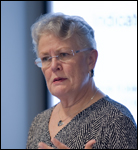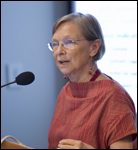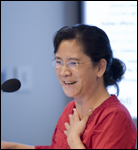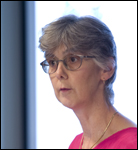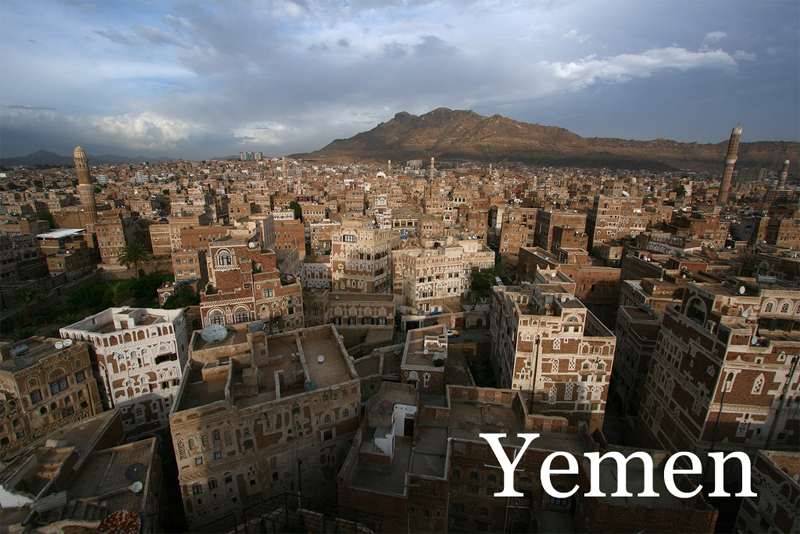-
Improving Monitoring, Transparency, and Accountability for Maternal, Newborn, and Child Health
›“There is a knowledge gap between global targets and locally owned goals,” said Sallie Craig Huber, global lead for results management at Management Sciences for Health (MSH). The seventh meeting of the “Advancing Policy Dialogue on Maternal Health” series – cosponsored by the Global Health Council, MSH, and PATH – comes at a critical time as world leaders meet next week at the high-level, plenary UN Summit to review progress toward the Millennium Development Goals (MDGs).
Panelists Marge Koblinsky, senior technical advisor, John Snow Inc., Ellen Starbird, deputy director, U.S. Agency for International Development, and Monique Widyono, program officer of PATH, discussed strategies for improving maternal health evaluation methods while balancing the interests of donors and beneficiaries.
Maternal Health Indicators: Contact vs. Context
“Skilled birth attendants [have] become the strategy [for improving maternal mortality rates], but one size does not fit all,” said Koblinsky. The proportion of births attended by skilled birth attendants is a key maternal health indicator; however, it is not sufficient and says little about what the attendants actually did during the birth.
Koblinsky demonstrated how other indicators such as near-miss morbidity, rates of cesarean section, and contraceptive prevalence rates (CPR) are better aligned with maternal mortality outcomes. “CPR is much more closely linked with the outcome we desire as [contraception] reduces pregnancies for those at higher risk and reduces unwanted births and unsafe abortions,” said Koblinsky.
“Are the present benchmarks enough?” asked Koblinsky. “The answer is no….Indicators based on contact with skilled birth attendants focuses attention on contact, not on the quality of care or event context.”
Qualitative Data Is Necessary
“When we talk about monitoring and evaluation, transparency and accountability, it’s really critical to engage [in a discussion] on how we gauge progress,” said Widyono. In the field, “collection of data varies widely and depends on the capacity of those collecting, aggregating, and analyzing the information,” said Widyono. Such inconsistencies demand increased investment in local research capacity and qualitative analysis.
Such engagement also provides an opportunity for feedback. This “qualitative data helps to reinforce, illuminate, and deepen the understanding of what this quantitative data is showing on the ground,” said Widyono. Moving forward, policymakers, donors, and program managers will need to find a balance between these two sets of data and work together to galvanize action.
“There is a lack of attention paid to developing local, sustainable research capacity,” said Widyono. “We have an obligation to build local research capacity and disseminate findings in collaboration with the people who are going to be affected by this data,” she said.
Innovation and Research
“We really need to think about monitoring and evaluation and research and innovation as a continuum,” said Starbird. “They reinforce each other and play different roles in helping us understand what makes programs work or why they are not working.”
“We have a myriad of indicators that we expect people to monitor, collect data for, and report back to headquarters in a way that has not given countries and programs the freedom to be country-specific,” said Starbird. Therefore, “one of the goals is to minimize the reporting burden and better coordinate around indicator definition with other donors,” she said.
In order to strengthen “M&E;” for maternal health, Starbird called for new indicators as well as new ways of thinking about data analysis. “Having a results framework is really important to do good monitoring and evaluation,” she said. Evaluating the relationship between inputs, outputs, outcomes, and impacts requires a wide range of data resources so we can “get under the numbers” and determine what needs to be improved, she said.
“It’s really important to have realistic goals, otherwise it’s difficult to put programs into place and get where we want to go,” said Starbird. She said that MDG 5.B, which calls for universal access to reproductive health, “is great, but there’s never going to be universal access to reproductive health. If we really want to make progress we need to define something that is achievable and is something we can come together around.”
In conclusion, it is necessary to provide “countries with the room to do what needs to be done locally, so we can better understand these concepts rather than imposing indicators on everybody,” said Starbird. -
Climate Science, Military and Gender Roles, and the Tibetan Plateau
›September 14, 2010 // By Geoffrey D. DabelkoHere are some useful links to environment, population, and security work that recently crossed my desk.
• Need a break from the raging debate set off by Halvard Buhaug’s Proceedings of the National Academy of Sciences quantitative-based critique of climate and African civil war linkages (or lack thereof)? Check out some of the correlations Cullen Hendrix and Idean Salehyan of University of North Texas find in their piece “After the Rain: Rainfall Variability, Hydro-Meteorological Disasters, and Social Conflict in Africa.”
• A German military think tank report worries about the economic and political implications of peak oil over a relatively short time frame.
• Militaries’ humanitarian responses to extreme weather events rather than actual shooting wars are the focus of “The Coming Conflicts of Climate Change,” by U.S. Navy Foreign Area Officer Michael Baker. Baker is writing for the Council on Foreign Relations as one of their International Affairs Fellows.
• Oxfam America and IUCN staff experts call for greater consideration of different gender roles in addressing climate change. UN climate institutions are targeted in the IPS story.
• Journalist Steve Solomon highlights the high politics of transboundary water in Asia with a piece in Forbes. China’s control of the Tibetan water tower with massive dam building amps up the pressure in South and Southeast Asia.
• Canadian scholar Eric Kaufmann’s book, Shall the Religious Inherit the Earth? breaks down relative population growth rates between the religious and the secular. One is high, one is below replacement level. So far the book is only published in Europe but you can get it from Amazon UK.
• The highly respected science journal Nature editorializes against the rising tide of loud anti-science demagoguery. Strong words on the U.S. political context.
Follow Geoff Dabelko (@geoffdabelko) and The New Security Beat (@NewSecurityBeat) on Twitter for more population, health, environment, and security updates. -
Yemen: Population, Environment, and Security Collide
›September 14, 2010 // By Schuyler NullThe Middle East is home to some of the fastest growing, most resource-scarce, and conflict-affected countries in the world. New Security Beat’s “Middle East at the Crossroads” series takes a look at the most challenging population, health, environment, and security issues facing the region.
Yemen is one of the most kinetic intersections of human and environmental security in the world. At the tip of the Arabian Peninsula, it is a natural gateway for those fleeing hardship in the conflict-wracked Horn of Africa, but observers are concerned it may soon resemble something much less than a haven.
Increased local resistance to a corrupt regime in Sanaa and an influx of Al Qaeda influence recently caused the CIA to reassess the franchise in Yemen as a more urgent threat to national security than the core Al Qaeda elements in Pakistan and Afghanistan.
In addition to these traditional security challenges, Yemen faces a bevy of population and environment-related problems. With its 22.8 million people, Yemen is growing faster than any other country in the Middle East – by 2050, it will rival Spain in total population. It is home to nearly a million impoverished migrants from East Africa, is almost totally reliant on groundwater that is being drained faster than can naturally be replenished, has an unemployment rate approaching 40 percent, the lowest rating in the world for gender equity, and almost no source of income besides oil exports, which have declined 56 percent since 2001 and are expected to continue sliding, barring any major new discoveries.
Beyond its more covert commitments, the United States has pledged over $210 million to Yemen for military, economic, and development assistance for this year alone. Is it enough to stave off collapse in one of the Middle East’s most troubled states?
For more see The New Security Beat’s full feature, “Demographics, Depleted Resources, and Al Qaeda Inflame Tensions in Yemen,” published earlier this summer.
Sources: Associated Press, Association for the Study of Peak Oil – USA, Central Intelligence Agency, Washington Post.
Photo Credit: Adapted from “Old Town Sanaa – Yemen 53,” courtesy of flickr user Richard Messenger. -
Climate-Security Linkages Lost in Translation
›A recent news story summarizing some interesting research by Halvard Buhaug carried the headline “Civil war in Africa has no link to climate change.” This is unfortunate because there’s nothing in Buhaug’s results, which were published in the Proceedings of the National Academy of Sciences, to support that conclusion.
In fact, the possibility that climate change might trigger conflict remains very real. Understanding why the headline writers got it wrong will help us better meet the growing demand for usable information about climate-conflict linkages.
First, the headline writer made a simple mistake by translating Buhaug’s modest model results — that under certain specifications climate variables were not statistically significant — into a much stronger causal conclusion: that climate is unrelated to conflict. A more responsible summary is that the historical relationship between climate and conflict depends on how the model is specified. But this is harder to squeeze into a headline — and much less likely to lure distracted online readers.
Buhaug tests 11 different models, but none of the 11 corresponds to what I would consider the emerging view on how climate shapes conflict. Using Miguel et al. (2004) as a reasonable representation of this view, and supported by other studies, there seems to be a strong likelihood that climatic shocks — due to their negative impacts on livelihoods — increase the likelihood that high-intensity civil wars will break out. None of Buhaug’s 11 models tested that view precisely.
If we are going to make progress as a community, we need to be specific about theoretically informed causal mechanisms. Our case studies and statistical tests should promote comparable results, around a discrete number of relevant mechanisms.
Second, a more profound confusion reflected in the headline concerns the term “climate change.” Buhaug’s research did not look at climate change at all, but rather historical climate variability. Variability of past climate is surely relevant to understanding the possible impacts of climate change, but there’s no way that, by itself, it can answer the question headline writers and policymakers want answered: Will climate change spark more conflict? For that we need to engage in a much richer combination of scenario analysis and model testing than we have done so far.
We are in a period in which climate change assessments have become highly politicized and climate politics are enormously contentious. The post-Copenhagen agenda for coming to grips with mitigation and adaptation remains primitive and unclear. Under these circumstances, we need to work extra hard to make sure that our research adds clarity and does not fan the flames of confusion. Buhaug’s paper is a good model in this regard, but the media coverage does not reflect its complexity. (Editor’s note: A few outlets – Nature, and TIME’s Ecocentric blog – did compare the clashing conclusions of Buhaug’s work and an earlier PNAS paper by Marshall Burke.)
The stakes are high. This isn’t a “normal” case of having trouble translating nuanced science into accessible news coverage. There is a gigantic disinformation machine with a well-funded cadre of “confusionistas” actively distorting and misrepresenting climate science. Scientists need to make it harder for them to succeed, not easier.
Here’s how I would characterize what we know and we are trying to learn:1) Economic deprivation almost certainly heightens the risk of internal war.
To understand how climate change might affect future conflict, we need to know much more. We need to understand how changing climate patterns interact with year-to-year variability to affect deprivation and shocks. We need to construct plausible socioeconomic scenarios of change to enable us to explore how the dynamics of climate, economics, demography, and politics will interact and unfold to shape conflict risk.
2) Economic shocks, as a form of deprivation, almost certainly heighten the risk of internal war.
3) Sharp declines in rainfall, compared to average, almost certainly generate economic shocks and deprivation.
4) Therefore, we are almost certain that sharp declines in rainfall raise the risk of internal war.
The same scenarios that generate future climate change also typically assume high levels of economic growth in Africa and other developing regions. If development is consistent with these projections, the risk of conflict will lessen over time as economies develop and democratic institutions spread.
To say something credible about climate change and conflict, we need to be able to articulate future pathways of economics and politics, because we know these will have a major impact on conflict in addition to climate change. Since we currently lack this ability, we must build it.Marc Levy is deputy director of the Center for International Earth Science Information Network (CIESIN), a research and data center of the Earth Institute of Columbia University.
Photo Credit: “KE139S11 World Bank” courtesy of flickr user World Bank Photo Collection.
-
New World Bank Report on Land Grabs Is a Dud
›After months of delays and false starts, and a tantalizing partial leak to the Financial Times earlier this summer, the much-ballyhooed World Bank report on large-scale land acquisitions has finally arrived.
-
Saleem Ali at TEDxUVM on Environmental Peacemaking
›“The use of the term ‘peace’ is in many circles still considered taboo, because immediately people think you are talking about something that is utopian,” said University of Vermont Professor Saleem Ali at a recent TEDx event on sustainability. “But I’m here to tell you that peace is pragmatic. Peace is possible.”
Ali points out the value of peace to every sector of society and, using an example from Ecuador and Peru, argues for the utility of the environment as a peacemaker. Other longstanding conflict areas like Cyprus, Iraq, Israel, and Korea are also ripe for environmental peacebuilding efforts, he says.
Professor Ali has written for The New Security Beat before on the strengths and weaknesses of viewing conservation and sustainability efforts through a strictly security lens. He points out that environmentalists must tread a fine line when assigning causality between the environment and conflict, but even when natural resources or climate are not central to a conflict, environmental peacebuilding can still play a role in creating shared ground (sometimes literally) between combatants.
“Treasures of the Earth,” Ali’s latest book, examines the thorny subject of how best to balance resource extraction in developing countries with long-term sustainability. Recent examples, such as Angola and Liberia’s blood diamonds, the DRC’s conflict minerals, and concerns over Afghanistan’s potential reserves have shown the difficulty in striking that balance.
“Ultimately, conflict trumps everything else” in terms of what we ought to be concerned with, Ali argues, and therefore, anyone, no matter their profession or capacity, should keep the pursuit of peace in mind – and all options on the table – when making decisions that affect others. -
The Dead Sea: A Pathway to Peace for Israel and Jordan?
›September 7, 2010 // By Russell SticklorThe Middle East is home to some of the fastest growing, most resource-scarce, and conflict-affected countries in the world. New Security Beat’s “Middle East at the Crossroads” series takes a look at the most challenging population, health, environment, and security issues facing the region.
Amidst the start of a new round of Middle East peace negotiations, the fate of the Dead Sea — which is divided between Israel, Jordan, and the West Bank — may not seem particularly relevant. But unlike the perpetually thorny political issues of Israeli settlement policy and Palestinian statehood, the Dead’s continuing environmental decline has sparked rare consensus in a region beset by conflict. Israelis, Jordanians, and Palestinians all agree that something must be done. The much more difficult question, however, is what. But no one is lacking for ideas.Who Stole the Dead’s Water?
Some 1,400 feet below sea level, the shoreline of the Dead Sea lies at the lowest dry point on the planet. Since the 1970s, this ancient inland saltwater sea has been changing, and fast, with the water level dropping at a rate of three feet per year. The region’s stifling heat and attendant high evaporation rates have certainly played their part. But the real culprits are irrigated agriculture and household water demand, spurred by population growth, which have siphoned off much of the precious little water that once flowed into the sea.
Historically, the Jordan River and its tributaries have contributed roughly 75 percent of the Dead’s annual inflow, or about 1.3 billion cubic meters per year. Even though the Jordan isn’t a large river system, it is an economic lifeline in this parched region. The basin’s waters have been tapped to the point of exhaustion by businesses, farms, and households in Israel, Jordan, the West Bank, and, father afield, Syria and Lebanon. With the cumulative population of those areas projected to increase by 68 percent between now and 2050 (or from 44.9 million today to 75.4 million by mid-century), strain on the region’s water supply will only increase with each passing year.
Already, the Jordan and its tributaries are far worse for the wear. Pollution is an ongoing concern thanks to untreated wastewater entering the river system, while a sprawling network of dams and other irrigation diversions to “make the desert bloom” has carried with it a hefty environmental price tag. The Jordan now delivers a scant 100 million cubic meters to the Dead each year, with up to 50 percent of that flow likely contaminated by raw sewage due to inadequate wastewater treatment upstream.
Meanwhile, water depletion rates in the Dead have been exacerbated by mineral-extraction companies on the sea’s southern reaches, which rely heavily on evaporation ponds to remove valuable minerals from the saltwater.
Tapping the Red
Attempts to internationalize the environmental dilemmas facing the greater Dead Sea region range from a proposed transborder “peace park” in the Jordan River valley to a global, internet-driven campaign to vote the Dead Sea as one of the seven natural wonders of the world. But by far the most ambitious — and controversial — idea for restoring the Dead Sea’s health is to build a 186-mile canal to bring in water from the Red Sea.
The plan has been around for decades, but has not gotten off the drawing board due to its large scale and costs. The project’s centerpiece would be a waterway built through the Arava Desert Valley along the Israeli-Jordanian border. Proponents on both sides of the border say the canal could help raise the Dead’s surface level, helping restore the area’s struggling ecosystems. And given the canal’s substantial elevation drop from sea level to shoreline, its waters could likely be harnessed for hydroelectricity, powering desalination plants that would provide new fresh water for the region.
The project could also harness cross-border environmental issues to transcend long-standing political and religious divisions between the region’s Jewish and Arab populations. “People are saying that water will cause wars,Dr. Hazim el-Naser in a 2002 interview on the canal project, when he served as Jordanian minister of water and irrigation. “We in the region, we’re saying, ‘No.’ Water will enhance cooperation. We can build peace through water projects.” Currently, the canal proposal is the subject of a World Bank feasibility study expected to be completed in 2011.
Deep Skepticism Remains
Still, as diplomatically and environmentally promising as a Red-Dead canal may seem, not everyone is on board with the proposed project. Environmentalists’ concerns run the gamut from unintended ecological impacts on the Dead Sea’s delicate chemical composition, to a sense that, even after decades of on-and-off consideration, the project is being pushed at the expense of other possible policy options.
The New Security Beat recently contacted Mira Edelstein of the international environmental nonprofit Friends of the Earth Middle East via email to discuss some of the group’s concerns about the canal. Edelstein highlighted some of the potential pitfalls of — and alternatives to — a canal link to the Dead:
New Security Beat: How have population growth and the corresponding rise in food demand in Israel, Jordan, and the West Bank affected the Dead Sea’s health?Mira Edelstein: The Jordanian and Israeli agricultural sectors still enjoy subsidized water tariffs, making it easy to continue growing water-intensive crops. But this depletes flows in the lower Jordan River system, and directly impacts the Dead Sea.
NSB: Why is your organization opposed to the idea of a Red-Dead canal link?ME: Friends of the Earth Middle East does not support a Red Sea link, as this option carries the risk of irreparable damage. We believe that this option will not only damage the Dead Sea itself — where the mixing of waters from two different seas will surely impact the chemical balance that makes the Dead Sea so unique — but also because we are worried that pumping such an enormous amount of water from the Gulf of Aqaba will likely harm the coral reefs in the Red Sea itself.
NSB: What steps do you propose to improve environmental conditions in the Dead Sea and the Jordan River valley?
Additionally, the Arava Desert Valley, where the pipes will be laid, is a seismically active region. Any small earthquake might damage the pipes, causing seawater to spill and polluting underground freshwater aquifers.ME: It all has to do with the water policies in the region. The governments [of Israel, Jordan, and the West Bank] desperately need to reform our unsustainable policies, and at the top of this list is agriculture. This means removing water subsidies and changing over from water-intensive crops to more sustainable crops appropriate for the local environment.
Sources: Friends of the Earth Middle East, Israel Marine Data Center, Israel Ministry of Foreign Affairs, National Geographic, the New York Times, Population Reference Bureau, United Nations, Washington Post, Waternet, the World Bank.
In addition, wastewater treatment plants need to be built throughout all of the Jordan valley region so that only treated wastewater is used for agriculture. Some of that treated water, and of course fresh water, should be brought back into the Jordan River system that will later flow into the Dead Sea…In addition, ecotourism projects should be encouraged, as they are an economic stimulus that can help support greater environmental conversation in the region.
Photo Credit: “Dead Sea Reflection,” looking east across the Dead Sea to the Jordanian shore, courtesy of flickr user Mr. Kris. -
GMHC 2010: Lessons Learned & Recommendations
›Over the last three days, 700 technical experts have provided solutions to decrease maternal mortality. In the last year, governments have committed billions of dollars to implement such solutions. Yet, we’ve been here before, reminded Sigrun Mogedal of the Norwegian Ministry of Foreign Affairs during the final plenary session of the Global Maternal Health Conference. “Just look at ICPD, Beijing, and CEDAW. Obviously, there must be something wrong with accountability,” she said, since 15 years later women continue to die every minute giving birth.
Wrapping up the conference with a discussion of accountability makes sense – we need to learn from the past and close the gap between commitments made and real action on the ground. So what does today’s buzzword, “accountability,” mean, and how do we enforce the realization of commitments made…or lack thereof?
“Accountability is power, and includes transparency, answerability, and enforceability,” said Lynn Freedman of Columbia University. Through international law, budget transparency, and grassroots mobilization it is possible to ensure that policies make a difference to improve women’s lives.
A review of the Ministry of Finance’s allocation for health can tell us a lot about the government’s real commitment to eradicating maternal mortality. As the overarching instrument of policy the “budget is inextricably linked to development and exists for those who have less,” said Helena Hofbauer of the International Budget Project. “If there were greater transparency of government spending, we could have done more to push for change five years ago,” said Hofbauer. This is indeed true; however, it is also true that if governments simply followed through on the international agreements they are signatories to, women would be better protected.
Accountability through the legal system is possible and Nancy Northrup of the Center for Reproductive Rights demonstrated how international law has overhauled programs and sparked governments into action. For example, in India, the high court recently ruled that the government must execute audits and report back on the steps taken to align programs with policies that ensure a woman’s right to skilled birth attendance.
In order to bring about such judicial interventions a social movement must first be in place to build awareness and demand accountability. Building such a movement starts at the grassroots level and Aparajita Gogoi of CEDPA presented strategies for empowering local communities with a global voice. By providing a safe space for dialogue, communities are given the opportunity to share concerns and demand action from local health facilitators and government officials.
Increasing opportunities for dialogue allows for bottom up solutions and ensures that contextual variables are taken into consideration. “We need arenas for brokering diverse groups to compare notes and streamline synergies, ” said Mogedal. I am energized by the lessons learned today and eager to apply these key messages next week in Washington, DC during the seventh meeting of the Advancing Policy Dialogue for Maternal Health at the Woodrow Wilson International Center for Scholars that will further address “Monitoring, Transparency, and Accountability for Maternal Health.”
Originally posted on the Medscape blog Global Mamma, by Calyn Ostrowski of the Woodrow Wilson International Center for Scholars, Coordinator of the Maternal Health Dialogue Series in partnership with the Maternal Health Task Force and UNFPA.
Photo Credit: “Mothers and children waiting at the Bolemba healt centre” courtesy of flickr user hdptcar.
 A Publication of the Stimson Center.
A Publication of the Stimson Center.

